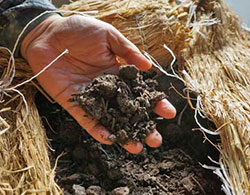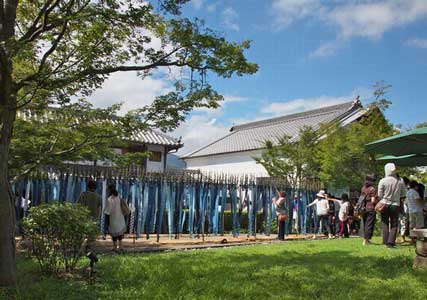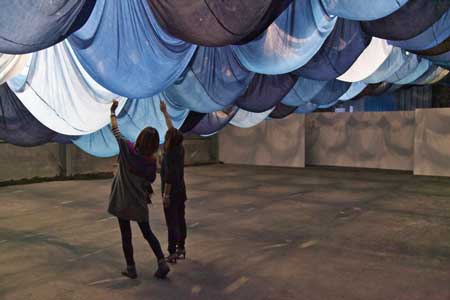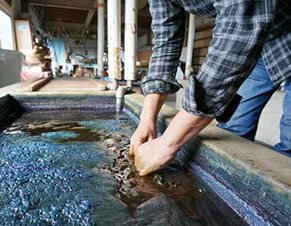Web Japan > Trends in Japan > Fashion&Design > Japan’s Blue Created With Indigo Dye
Japan’s Blue Created With Indigo Dye
Advances merging traditional techniques and new ideas
Indigo dye is a traditional Japanese staining technique. Recently however, advances are being made by merging the old and new, including the use of rich indigo tones for stylish fashion combinations and interior design. Indigo dye—which creates more beautiful tones with use—has not only taken root in Japan, but is also renowned around the world as ‘Japan Blue.’

Illuminated artwork featuring 247 sheets of colorfully dyed indigo cloth connected together (Courtesy of Awa Natural Indigo ×Shape in the future Project)
A time-served art
 Dried indigo leaves (Courtesy of Aizome Craft Gallery)
Dried indigo leaves (Courtesy of Aizome Craft Gallery)
|
 Fermented indigo leaves (Sukumo) (Courtesy of Aizome Craft Gallery)
Fermented indigo leaves (Sukumo) (Courtesy of Aizome Craft Gallery)
|
Japan’s indigo dye is made from the polygonum plant. First, the indigo leaves are dried, then watered for 3 or 4 days for approximately 3 months and carefully mixed to ferment the leaves and create the raw ingredient for the dye, also known as ‘Sukumo.’
Ash lye (Aku) made of water and ash is added to the Sukumo to create the liquid compound used as a dye. The most important thing when making Sukumo is to carefully monitor the amount of water added to the Sukumo and the fermentation temperature. A skilled artisan must take meticulous care until completion. When a piece of thread, etc., is dipped into this liquid and then aerated, the dye oxidizes to create a beautiful indigo color. Dipping into the dye repeatedly will create an even richer color.
In 1880, a chemical synthesis blue component referred to as synthetic indigo was developed in Germany, which saw a rapid surge in imports to Japan while the naturally derived indigo dye experienced a sharp decline in popularity. Recently however, naturally derived indigo dye has gained favor again for its safety factor and lasting color compared to the chemical synthesis.
Newly created fashion

Fashion show using indigo dye © AM MODEL AGENT
Indigo dye produced in the manner described above has long been used for traditional Japanese women’s clothing such as summer kimonos (Yukata). It is said that in the olden days, Japanese women preferred to wear a Yukata dyed with indigo for evening walks in summer to prevent insect bites due to its insect-repellent properties.
Nowadays, such properties may have been forgotten but the beautiful tones are being recognized as new fashion is created one after another using indigo dye for modern clothes such as women’s dresses and coats, as well as children’s clothing. The traditional dyeing technique has been revived by the fashion world for a fresh new look.
For example, indigo dye used on a dress in a tie-dye pattern creates a chic look reminiscent of the blue sea. Also, a woman’s coat dyed with indigo at the waist makes a strong impact. Kids fashion items such as hats, shirts with the backs boldly dyed indigo, and even shorts, make it fun to play with the different depth of blue.
Projects to create a new culture

Flooring made of Japanese cedar stained with indigo dye at the Tokushima City Library Gallery © Dairi Lumber Co., Ltd.

Linen in various shades of indigo are suspended against the blue sky and surrounding vegetation, charming visitors at the indigo art outdoor exhibition. (Courtesy of Awa Natural Indigo ×Shape in the future Project)
Shikoku is the smallest of the 4 main islands which form the Japanese archipelago together with Hokkaido, Honshu, and Kyushu. Shikoku’s Tokushima Prefecture actively produced indigo dye compound during the Edo Period (1603-1868), and remains Japan’s leading production region even today for indigo dye and related products. In fact, the region has been launching various projects featuring indigo dye, such as indigo dye factory visits and hands-on activities using indigo dye.
One project that stands out is the production of building materials combining indigo dye and cedar wood. Indigo-stained cedar wood was used for the flooring of the gallery space at the Tokushima City Library, making this library a sight to see in Japan. The indigo color accentuates the cedar wood grain for a modern twist on a Japanese classic. White walls give the space a sense of contrast. What’s more, Tokushima Prefecture has launched the “Awa Natural Indigo×Shape in the future Project” in order to draw attention in Japan and abroad towards indigo produced in Tokushima. The project’s objective is to create a lifestyle and a new sense of value tinged with Tokushima indigo; it has conducted various activities such as art exhibitions and fashion shows, T-shirt-making contests and workshops using indigo dye, etc. One such activity that has drawn attention nationwide is an art exhibition featuring artwork using indigo dye. The exhibition at a warehouse in Tokushima City in December 2012 featured a unique piece displaying 247 sheets of indigo dyed cloth suspended from the ceiling. Praised by visitors, the difference in color of each sheet is a miraculous expression of each sheet’s texture and thickness. While conserving a long tradition, Japanese indigo dye is generating a new culture in Japan that extends much further than just fashion.

Visitors cut out round badges out of their favorite shade cloth. Exhibited works include strips of cloth from which circular holes have been cut.(Courtesy of Awa Natural Indigo ×Shape in the future Project)

Touchable indigo dye exhibit (Courtesy of Awa Natural Indigo ×Shape in the future Project)
(January 2014)


